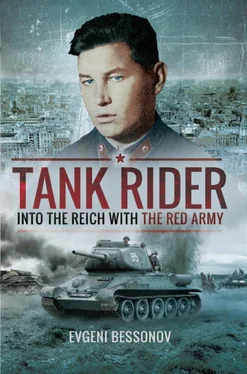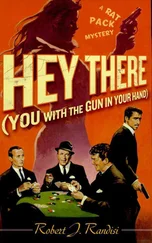Shtokolov, in turn, went to the battalion commander and exclaimed: ‘This is how you should fight the war! I just went there and captured the German trenches, the Germans fled and as a proof here is the machine-gun that I personally captured in battle. This is how partisans fight!’
When I reported to the battalion commander about the completion of his order, he rebuked me for cowardice as a reply!
The day was quiet; the Germans did not show up or open fire at us.

As darkness descended, I inspected the foxholes, cheering the soldiers up, especially the green ones, and warned them that they should not leave their positions without orders, otherwise the Germans would slaughter us all. As soon as I walked away from the left flank of the company, the Germans sent a strong artillery and mortar barrage against us, making use of six-barrelled mortars. The Germans rarely used them; they did not have many. It was a strong weapon, but could not be compared with the Katyusha. We called that mortar ‘ Vanyusha ’, in other places they called it something different, a donkey, for example. Sergeant Savkin, my orderly, and I had nowhere to hide, there was firing all around us, and we lay down under the steep riverbank. Shells and mines from the six-barrelled mortar exploded, red-hot splinters were flying in the air – it was all shining against the background of a night sky. It was sheer hell. It is incomprehensible how we survived. The horrible crash and noise of the guns that must have been stationed close to us filled the air. I had not experienced such heavy bombardment for a long time, not since fighting at Kursk in 1943. All this fire descended on a single company, 25 or 30 soldiers. Apparently, the Germans were very angry and upset because we drove them away from the village with losses in soldiers and weapons in the daytime, when they did not expect the attack and while they were having their nice lunch. Losing a weapon is infamy for a soldier.
The barrage lasted 20 or 25 minutes, although how could I check my watch at that time? Not only the green soldiers, but also the old hands, were very scared as well. I can’t lie, I was scared too, especially given the fact that there was no shelter to hide in. After the barrage was over, the Fritzes attacked with superior forces. The soldiers of the company could not take the fire, and fled again. The experienced soldiers put up some resistance, but then they also withdrew to the bridge with the fleeing green soldiers. I could not stop the retreat from the trenches, even less now that some soldiers were wounded and we had to carry them on rain capes. I decided to leave the western bank, reported this decision to the battalion commander and received the order to leave the bridgehead and take position to the left of Shtokolov’s 2nd company.
It is interesting that several days later Shtokolov with his company (without our participation) wanted to drive the Germans out of their positions on the western bank of the river, but got almost completely wiped out. Only a small group of partisans, including Shtokolov himself, survived. The Germans were finishing them off as they ran in the open to their foxholes on our (eastern) bank of the river.
The battalion commander saw the hurricane of fire that descended on the company and apparently realized that it was impossible to hold the other bank, and there was no point in that. Half of the newcomers were out of action, mostly wounded, and again I had almost no soldiers left.
From my point of view, one cannot send untrained soldiers, who are not used to army and front line discipline, straight into battle. As our company’s Sergeant Nikolai Chulkin told me after the war, many of those recruits hid in their trenches, put their guns on breastworks and fired without aiming. I never saw anything like that. Two or three soldiers were picked off by the Germans at point-blank range, but still managed to jump out of the trenches and dropped unconscious only after they reached the bridge. The battalion’s medic told me that one of those recruits had fourteen bullet wounds, but survived. In the very first German attack two soldiers, Chaschin and Khalilov, went missing in action, as they got scared and ran off in the wrong direction. One of them, Chaschin, came back after almost a month, while the second guy joined another unit.
That was the end of my adventures on the bridgehead at the Strypa river in April 1944. The company dug in at the high bank of the river. Days quietly passed by, the Germans did not bother us, and we did not fire on them much. Sometimes our Brigade artillery fired on the targets that they spotted, but that was quite rare. We did not see our company commander, Lieutenant Chernyshov, I think he was sent to receive additional personnel in the rear or somewhere else. To the right of us were defences of the 2nd company, where I had a friend – platoon leader Alexei Belyakov, while Senior Lieutenant Shtokolov was appointed the 2nd company’s commander. He had arrived shortly before from the reserve and had already caused a stir. Lieutenant V. K. Mochalov arrived in late March or early April to fill the position of the machine-gun platoon leader of a machine-gun company. He stayed in our company, as there were no machine-guns or machine-gun crews. We continued to feed on the poultry of the villagers from the village that the Germans had driven us out of, Dobropolie. In the mornings two or three soldiers would go to that village, bring chicken or something else and we would boil this in canteens over the fire. By that time the Germans had abandoned the village and dug in on the hill behind the village.
On 27 April, 1944, an infantry unit replaced the Brigade, and we went into reserve. The battalion was transferred into rear area, and we stationed ourselves at a forest edge in vicinity of Kopychintsy town.
During the two months of action in the Kamenets-Podolsk operation of March and April of 1944 we suffered significant losses in personnel and military hardware, especially tanks. We had travelled over 350 kilometres in action during this period. Our Brigade liberated the towns of Manachin, Podvolochisk, Volochisk, Skalat, Gusyatin and Kamenets-Podolsk. Writing about losses in the battalion is the hard part, but I am obliged to show to our descendants how hard it was to achieve victory, and how much blood we shed to achieve it.
The three motor rifle companies of our 1st motor rifle battalion had at least 300 soldiers at the beginning of Kamenets-Podolsk operation (3 March, 1944), 100 soldiers in a company. When we disengaged, the 1st and the 2nd company that was combined with the 1st had no more than 20 or 25 men including me. The 2nd company (former 3rd company) had even less, 10 or 12 men, together with Junior Lieutenant Belyakov, which put the total strength of the battalion at just 30 or 35 men. I cite the numbers excluding the new soldiers that were recruited in early and mid-April, but they also suffered losses in action at Dobropolie village. Losses in the three companies were almost 90%.
The machine-gun company of the battalion also suffered significant losses – all the Maxim machine-guns, the main support weapon of our motor rifle companies, were knocked out together with their crews. Before the operation the company had 40 or 50 soldiers. The anti-tank rifle company, which also had some 40 or 50 men, merely ceased to exist. The mortar company lost its mortars and most of its men – before the battle it had 30 or 35 soldiers, out of whom only platoon commander Lieutenant M. P. Zaitsev was left. The artillery battery (45 mm guns) lost all its guns, and the majority of the battery men were killed or wounded. Before the operation the battery had 25 or 30 men.
Читать дальше













